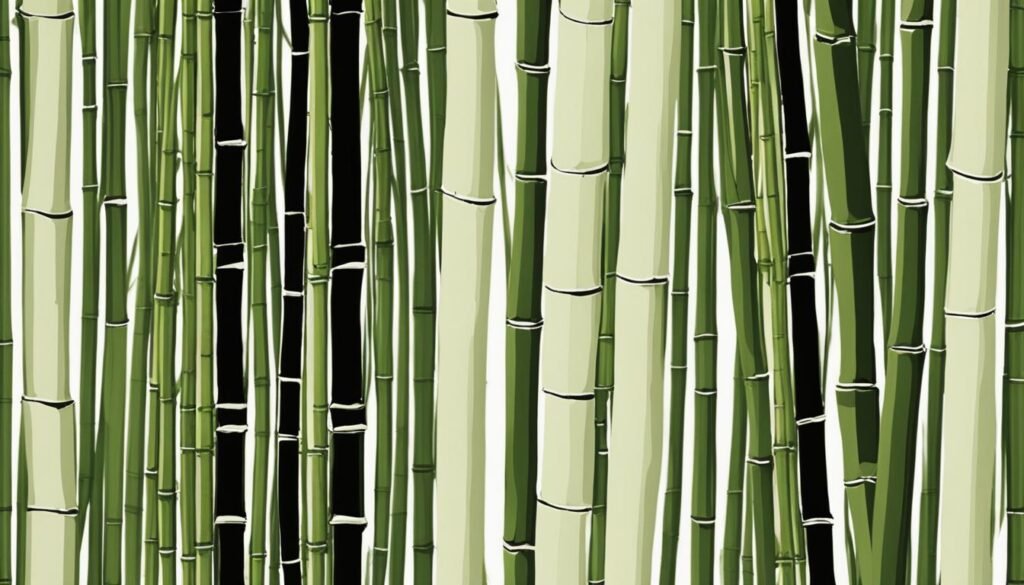Bamboo, with its elegant and resilient nature, has long been a symbol of deeper meanings in both literature and art. It holds a profound cultural significance and is frequently used to convey messages of strength, growth, and balance. In this article, I will delve into the symbolic meaning of bamboo and its role in literature and art, exploring its presence in classic works and its artistic representation across various mediums.
Key Takeaways:
- Bamboo’s symbolism in literature and art reflects its cultural significance and profound impact on various societies.
- It is often used to convey themes of strength, flexibility, growth, luck, health, harmony, and balance.
- Bamboo’s symbolism offers valuable lessons on resilience, adaptability, and the pursuit of knowledge.
- Its representation in ancient literature and visual arts showcases its enduring relevance and timeless appeal.
- The multifaceted symbolism of bamboo continues to inspire artists and writers in their creative endeavors.
Bamboo in Ancient Literature
Bamboo holds a significant place in ancient literature, particularly in works from China and Japan. Poets frequently incorporated bamboo imagery to convey ideas of purity, elegance, and resilience. Bamboo was often used as a symbol of virtue and nobility, representing the qualities that individuals should aspire to. Its graceful and enduring nature made it a powerful metaphor in literary works from this time.

In ancient literature, bamboo was deeply revered for its symbolic meaning. The lush greenery and graceful swaying of bamboo stalks inspired poets and writers, who used its imagery to evoke a sense of beauty and serenity.
“Amidst the bamboo grove, a gentle breeze whispers
I find solace in its tranquil embrace
Purity and virtue, embodied in every leaf and stem”
Literary references to bamboo were found in ancient Chinese and Japanese poetry and prose. The plant’s association with nobility and virtue elevated its significance, making it a cherished symbol in these cultures.
Bamboo’s resilience and ability to bend without breaking resonated deeply with ancient writers, who saw it as a reflection of the human spirit. Just like bamboo, individuals were encouraged to endure hardships with grace and maintain their integrity in the face of adversity.
The symbolism of bamboo in ancient literature continues to captivate readers today, reminding us of the qualities we should strive for and the inner strength we possess.
| Symbolism in Ancient Literature | Cultural Context |
|---|---|
| Bamboo as a symbol of virtue and nobility | China and Japan |
| Poetic references to bamboo’s elegance and resilience | Ancient Chinese and Japanese poetry |
| Metaphorical representation of human endurance | Reflection of cultural values |
Visual Arts and Bamboo Depictions
Bamboo’s symbolic beauty extends beyond literature and finds expression in visual arts, such as paintings and calligraphy. Artists have skillfully represented the essence of bamboo, capturing its tranquility and resilience through their brushstrokes.
The artistic representation of bamboo symbolism in paintings and calligraphy allows for a deeper exploration of its meanings. The graceful lines of bamboo stalks, depicted with precision and elegance, create a sense of harmony and serenity in the artwork. Through these visual interpretations, bamboo emerges as a symbol of tranquility and resilience.
The simplicity and elegance of bamboo resonate with artists, who often incorporate it as a central motif in their works. Its presence evokes a calming effect, inviting viewers to reflect upon the strength and adaptability found in nature. The delicate balance of strength and flexibility embodied by bamboo becomes a metaphor for the human experience, inspiring us to find inner tranquility amidst life’s challenges.
Artists use various techniques to convey the beauty and symbolism of bamboo in their artwork. Some employ intricate brushwork to capture the fine details of its leaves and stalks, while others utilize negative space to represent the hollow interior of the bamboo. These techniques bring a sense of depth and texture to the artwork, enhancing its overall visual impact.
“Bamboo symbolizes tranquility, resilience, and the ability to adapt to changing circumstances. Through my paintings, I aim to evoke a sense of calmness and inspire viewers to embrace these qualities in their own lives.” – Renowned painter, Li Wei
The artistic representation of bamboo symbolism in visual arts serves as a reminder of the power of nature to inspire and convey deeper meanings. It encourages viewers to appreciate the beauty and symbolism found in the simplest of elements, and to seek tranquility and resilience in their own lives.
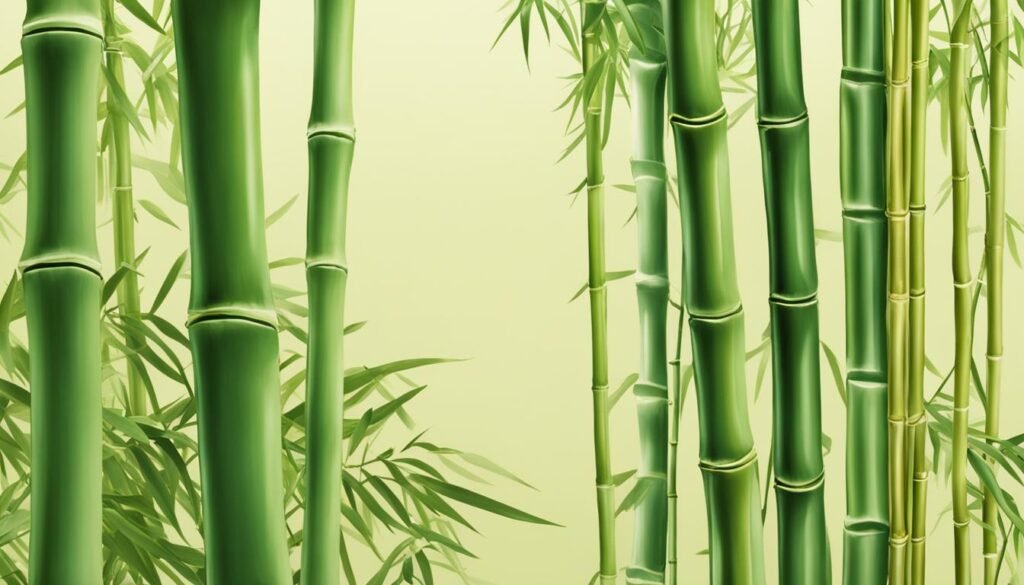
Bamboo in Martial Arts Heritage
Bamboo holds a special place in the rich heritage of martial arts. Its symbolism resonates deeply with practitioners, embodying qualities of strength and flexibility that are integral to their training and philosophy.
Inspired by the bamboo’s remarkable ability to withstand external forces without breaking, martial artists draw important lessons of resilience and adaptability. Just as bamboo bends with the wind, they learn to weather the challenges of combat and life, remaining unyielding in their commitment to their practice.
The symbolism of bamboo extends beyond physical strength. It represents the harmonious balance between power and flexibility, reminding practitioners that true strength lies not in brute force, but in the ability to adapt and respond with grace and precision.
Bamboo’s significance in martial arts philosophy is rooted in the principles of Taoism, which emphasizes the importance of flow, balance, and harmony. Like the bamboo, martial artists strive to embody these principles, cultivating an inner strength that allows them to adapt to any situation.
“The bamboo represents strength, flexibility, and resilience – essential qualities for any martial artist. It teaches us to flow with the challenges we face, remaining strong yet adaptable in the face of adversity.”
Bamboo is not merely a symbol; it is also incorporated into training tools. The strength and durability of bamboo make it an ideal material for weapons such as staffs and swords, providing martial artists with reliable and powerful instruments for their practice.
Furthermore, bamboo serves as a visual reminder of the martial artist’s commitment to personal growth. Just as bamboo shoots rapidly reach for the sky, practitioners strive for continuous improvement, honing their skills and deepening their understanding of their craft.
Bamboo Symbolism in Martial Arts Philosophy
Bamboo symbolism runs deep within the martial arts philosophy, permeating all aspects of training and mindset. Its teachings encourage practitioners to embrace the duality of strength and flexibility, to adapt to changing circumstances, and to find harmony within themselves and the world around them.
| Symbolism | Meaning |
|---|---|
| Strength | Bamboo represents physical and mental strength, reminding martial artists of the importance of inner fortitude in the face of challenges. |
| Flexibility | Just as bamboo bends with the wind, martial artists learn to be flexible and adaptable, allowing them to overcome obstacles and respond effectively in combat. |
| Resilience | Bamboo’s ability to withstand external forces without breaking serves as a reminder to martial artists to remain steadfast and resilient in the face of adversity. |
| Adaptability | By observing the bamboo’s ability to thrive in diverse environments, martial artists learn the importance of adapting to different situations and finding creative solutions. |
| Harmony | Bamboo symbolizes the harmonious balance between strength and flexibility, reminding practitioners to cultivate a balanced approach to their training and their lives. |
The significance of bamboo in martial arts heritage goes beyond its physical attributes. It serves as a powerful symbol of values and principles that martial artists strive to embody, guiding them on their journey of personal growth, discipline, and self-discovery.
Spiritual Meaning in Various Cultures
Bamboo holds symbolic significance in various cultures around the world. One of the most prominent cultures that attribute deep symbolism to bamboo is Chinese culture. In Chinese symbolism, bamboo is associated with virtue and reflects the souls and emotions of people. It represents positive qualities such as resoluteness, moral integrity, and modesty.
In the Philippines, bamboo is believed to possess healing properties and is revered for its ability to grant wishes. The indigenous cultures of Vietnam and Polynesia also have their own myths and legends surrounding bamboo. In these cultures, bamboo is associated with strength, creation, and divine power.
The diverse interpretations of bamboo symbolism across different cultures highlight its profound impact and cultural significance. These beliefs and legends demonstrate the deep-rooted connection between humans and nature, and the symbolism of bamboo serves as a unifying element in our shared human experiences.

Whether it’s a bamboo forest swaying gracefully in the wind or a delicate brushstroke capturing the essence of bamboo on a canvas, the symbolism of strength and flexibility resonates deeply. Bamboo’s graceful ability to bend without breaking reminds us that true strength often manifests in adaptability. The resilience symbolism of bamboo teaches us to be open to change, to adjust our course when necessary, and to find inner fortitude in the face of challenges.
“The bamboo that bends is stronger than the oak that resists.”
As the famous quote suggests, bamboo’s ability to bend makes it stronger than an oak tree that stubbornly resists. It serves as a powerful reminder to embrace flexibility and adaptability in our own lives. Just like bamboo, we can learn to navigate through life’s obstacles by being resilient, nimble, and willing to find alternative paths. By embodying the symbolism of bamboo, we gain the strength to overcome adversity while remaining true to ourselves.
Symbolism of Bamboo in Literature
Bamboo’s symbolism of strength and flexibility is also evident in literature. In numerous literary works, bamboo is used as a powerful metaphor for resilience and adaptability. Through vivid descriptions and poetic imagery, authors convey the beauty of bamboo and the valuable life lessons it represents.
- In ancient Chinese literature, bamboo often symbolizes the qualities of humility, strength, and moral integrity. Just like bamboo, individuals are encouraged to remain steadfast in their values while being flexible and adaptable.
- In Japanese haiku poetry, bamboo is praised for its ability to endure harsh seasons, symbolizing the resilience and unwavering spirit of the human soul.
- Contemporary literature also explores the symbolism of bamboo, using it as a reminder to embrace change, overcome obstacles, and find inner strength in challenging times.
Whether woven into myths, expressed through poetry, or embedded in narrative prose, bamboo’s symbolic representation of strength and flexibility continues to inspire and captivate readers.
Symbolism of Bamboo in Art
Bamboo’s symbolism of strength and flexibility is not only found in literature but also deeply rooted in the world of art. Artists from various cultures and time periods have captured the essence of bamboo in their creations, using it as a powerful symbol to convey resilience and adaptability.
In traditional Chinese brush painting, bamboo is depicted with delicate brushstrokes, portraying its beauty, elegance, and the harmony it represents. The flowing lines and gentle curves of bamboo stalks convey both strength and flexibility, reminding viewers of the importance of adaptability in life.
Similarly, bamboo is a popular subject in Japanese ink wash painting, where it symbolizes the quiet strength and resilience found in nature. Through subtle brushwork and shades of black and gray, artists evoke the image of bamboo bending with the wind, reflecting the ability to adapt and remain unbroken.
Bamboo’s symbolism transcends cultural boundaries, appearing in Western art as well. Artists worldwide have explored the theme of strength and flexibility through bamboo, using its imagery to represent the human spirit’s capacity to navigate through life’s challenges.
By incorporating bamboo in their artworks, whether in paintings, sculptures, or other mediums, artists pay homage to its symbolic importance and invite viewers to reflect on the lessons it holds.
Growth and Wisdom Associations
Bamboo’s remarkable ability to grow rapidly has made it a powerful symbol of personal growth and development. Just like bamboo shoots soaring towards the sky, humans have an innate desire for continuous self-improvement and progress.
The bamboo plant’s hollow interior holds a deeper meaning in the pursuit of wisdom and enlightenment. It represents the concept of emptiness, encouraging individuals to open their minds and explore new knowledge and ideas. Embracing this symbolism, we can nurture our own personal growth and strive for a deeper understanding of life’s mysteries.
Just as bamboo thrives and flourishes in different environments, it reminds us to be adaptable and resilient in the face of challenges. Its symbolism teaches us to be open to change, willing to bend but never break, and to embrace the opportunities for growth and transformation that come our way.
The symbolism of bamboo in personal development and wisdom reflects the belief that no matter our age or circumstances, there is always room for growth and the pursuit of knowledge. By embodying the qualities of bamboo – resilience, adaptability, and a thirst for wisdom – we can cultivate a mindset of continuous learning and personal transformation.
| Symbolic Association | Description |
|---|---|
| Growth | Bamboo symbolizes personal growth and development, reminding us to continually strive for self-improvement. |
| Wisdom | The hollow interior of bamboo represents emptiness, signifying the pursuit of wisdom and enlightenment. |
| Resilience | Bamboo’s ability to withstand challenges without breaking teaches us to be adaptable and resilient in the face of adversity. |
The Symbolic Power of Bamboo in Personal Development
“Like bamboo, I am continuously fueling my growth, embracing resilience in the face of challenges, and seeking wisdom and enlightenment with an open mind and heart.”
Understood as a symbol of growth, wisdom, and resilience, bamboo’s powerful metaphor inspires individuals to embrace personal development and lifelong learning. Its symbolism encourages us to nurture our inner strengths, adapt to change, and embrace the transformative power of wisdom and enlightenment.
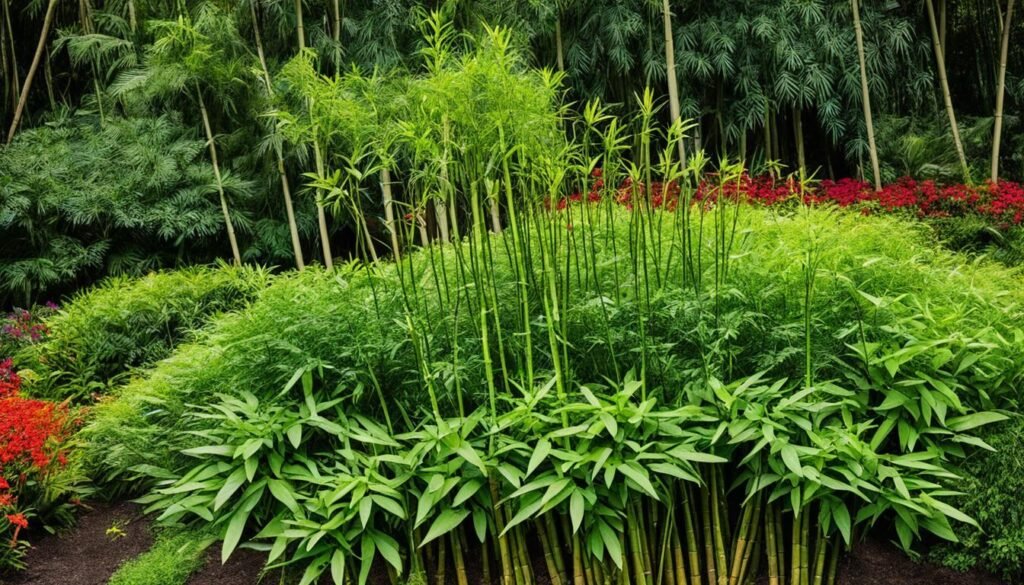
Bamboo as a Sign of Luck and Prosperity
Bamboo holds a special place in Chinese culture, where it is considered a symbol of luck and prosperity. Its association with blessings and good fortune has made it a popular element in homes and businesses. Whether used as a gift or a decorative item, bamboo brings a sense of positivity and abundance to its surroundings.
In Chinese beliefs and traditions, the number of bamboo stalks also holds significance. Different numbers represent different types of luck, allowing individuals to customize their blessings according to their needs. For example:
- One stalk: Represents growth and new beginnings, making it ideal for individuals starting a new venture or embarking on a personal journey.
- Two stalks: Symbolize love and partnerships, making them a popular choice for couples or those seeking harmony in their relationships.
- Three stalks: Signify happiness, long life, and prosperity. They are often given as a wish for good fortune and success in various aspects of life.
- Five stalks: Associated with academic achievement and intellectual growth, making them a favored choice for students or those pursuing knowledge.
- Eight stalks: Considered especially auspicious, representing wealth, abundance, and financial success.
These various combinations of bamboo stalks offer individuals the opportunity to invite specific blessings into their lives or create an environment of abundance and prosperity.
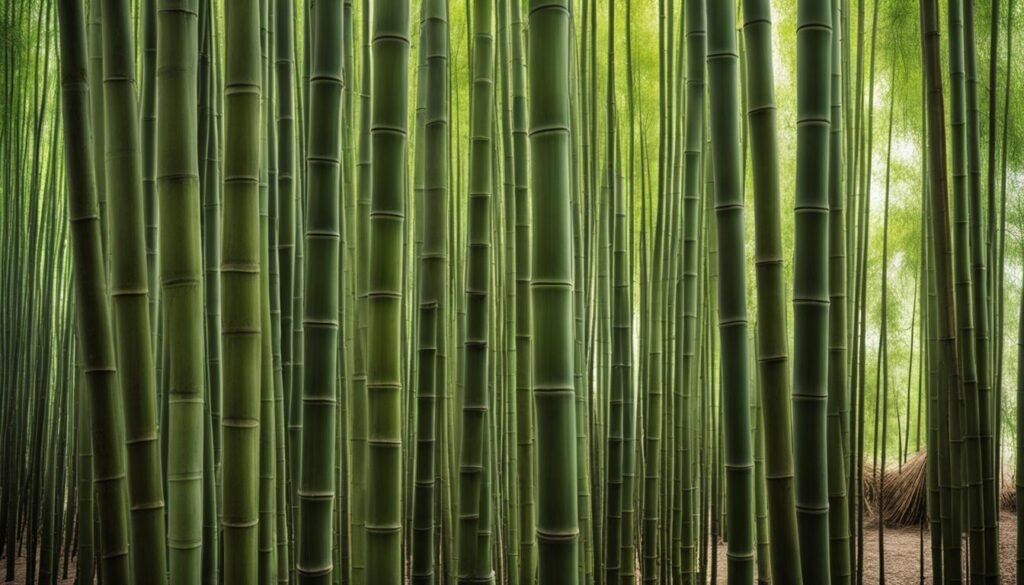
Bamboo in Finding Balance:
| Bamboo Symbolism | Meaning |
|---|---|
| Flexibility | Teaches us to adapt to changing circumstances and find balance in life’s uncertainties. |
| Interconnectedness | Reminds us of the importance of harmonious relationships and interconnectedness with nature and others. |
| Unity | Symbolizes the strength in collaboration and working together towards a common goal. |
| Harmony | Represents the balance between the physical, mental, and spiritual aspects of our lives. |
Bamboo in Everyday Life
Bamboo is not only a symbol of strength and resilience but also a versatile resource that finds practical applications in our everyday lives. Its unique properties make it an ideal material for various purposes, ranging from construction and furniture to tools and crafts. Additionally, bamboo has culinary and medicinal uses, further highlighting its significance in different aspects of our daily routines.
Construction and Furniture
Bamboo’s strength and durability make it a popular choice for construction projects and furniture manufacturing. Its natural resilience allows it to withstand heavy loads and resist warping or shrinking over time. Bamboo flooring, for example, offers an eco-friendly alternative to traditional hardwood, exhibiting both beauty and sustainability. In furniture design, bamboo is used to create stylish and sturdy pieces, adding an element of natural elegance to any space.
Tools and Crafts
The versatility of bamboo extends to the realm of tools and crafts. Its lightweight yet robust nature makes it an excellent material for crafting various handheld tools, such as gardening implements, fishing rods, and musical instruments. Bamboo is also used in the creation of intricate handicrafts, including baskets, mats, and decorative items. The flexibility and workability of bamboo allow artisans to weave, carve, and shape it into intricate designs, showcasing the craftsmanship and artistic potential of this remarkable plant.
Culinary and Medicinal Applications
Beyond its physical properties, bamboo has found its way into our kitchens and medicine cabinets. In culinary practices, bamboo shoots are a popular ingredient, adding a delicate flavor and crisp texture to many dishes. Boasting nutritional benefits, bamboo shoots are rich in fiber, vitamins, and minerals. In traditional medicine, various parts of the bamboo plant, such as leaves, roots, and sap, are utilized for their healing properties. Bamboo-based herbal remedies are believed to address ailments ranging from inflammation to digestive disorders, harnessing nature’s power for holistic well-being.
Overall, bamboo’s widespread use in everyday life serves as a testament to its cultural significance and practicality. From the humble construction site to the elaborate dining table, bamboo’s strength, versatility, and natural beauty continue to shape and enrich our daily experiences.
Bamboo Uses in Everyday Life
| Category | Applications |
|---|---|
| Construction | Construction projects, flooring, scaffolding |
| Furniture | Tables, chairs, beds, shelves |
| Tools and Crafts | Gardening tools, fishing rods, musical instruments, baskets, mats |
| Culinary | Bamboo shoots in various dishes |
| Medicinal | Herbal remedies, natural healing practices |

The Philosophy of Bamboo
Bamboo holds philosophical lessons in adaptability and simplicity. Its ability to adapt to different environments and withstand changing circumstances teaches us the importance of flexibility and resilience in life. Bamboo’s simplicity and unadorned beauty remind us to appreciate the beauty in simplicity and to embrace a more minimalist mindset. Its philosophy serves as a guide for finding contentment and fulfillment in our lives.
Lessons in Adaptability
The resilience of bamboo in the face of diverse conditions is a testament to its adaptability. Just as bamboo bends with the wind, we learn to navigate life’s challenges by being flexible and adaptable. The philosophy of bamboo encourages us to embrace change and find ways to thrive in different environments.
| Lesson | Explanation |
|---|---|
| Flexibility | Bamboo’s ability to bend without breaking teaches us to be open-minded and adaptable, allowing us to adjust our plans and perspectives when necessary. |
| Resilience | Like bamboo, we can develop the strength to endure setbacks and challenges, bouncing back with resilience and determination. |
| Acceptance of Change | The philosophy of bamboo encourages us to embrace change as a natural part of life, finding opportunities for growth and renewal in every transition. |
The Beauty of Simplicity
Bamboo’s unadorned beauty and elegant simplicity serve as a reminder to appreciate the beauty in the simple things in life. In a world filled with complexity and distractions, the philosophy of bamboo encourages us to find joy and contentment in the minimalist aspects of our existence.
“Simplicity is the ultimate sophistication.” – Leonardo da Vinci
By adopting a more minimalist mindset, we free ourselves from the burden of excessive material possessions and the search for constant stimulation. Bamboo teaches us to find fulfillment in the essentials and to cultivate a sense of tranquility and harmony in our surroundings.
Embracing the Philosophy of Bamboo
As we delve into the philosophy of bamboo, we gain valuable insights and guidance for living a meaningful and fulfilling life:
- Adapt to change with flexibility and resilience.
- Embrace simplicity and find beauty in the minimalist aspects of life.
- Cultivate a sense of contentment and harmony with the natural world.
- Appreciate the strength that comes from bending without breaking.
The wisdom of bamboo’s philosophy reminds us of the importance of inner growth, self-reflection, and living in harmony with our surroundings. By incorporating these lessons into our lives, we can navigate the complexities with grace and find true fulfillment.

According to feng shui principles, different arrangements and the number of lucky bamboo stalks have specific meanings. For example, a single stalk symbolizes simplicity and clarity, while two stalks represent love and partnership. Three stalks symbolize happiness, wealth, and longevity, while five stalks symbolize balance and the five elements of feng shui: wood, fire, earth, metal, and water. The significance of lucky bamboo arrangements can vary depending on personal intentions and goals.
Bamboo and Complementary Plants
In feng shui practice, bamboo is often paired with other plants to create a harmonious flow of energy and balance in a space. These complementary plants work together to enhance the positive energy and create a more vibrant and harmonious environment. Some popular plants that are often combined with bamboo are:
- Lucky Bamboo and Orchids: Orchids symbolize love, beauty, and fertility. When paired with lucky bamboo, they create a powerful combination of luck, positive energy, and growth.
- Lucky Bamboo and Peace Lily: Peace lilies are known for their air-purifying qualities and are believed to bring peace and tranquility to a space. When combined with lucky bamboo, they enhance the positive energy and create a peaceful and harmonious ambiance.
- Lucky Bamboo and Money Plants: Money plants, also known as jade plants or Crassula ovata, are believed to attract wealth and abundance. When placed with lucky bamboo, they amplify the prosperity and bring good fortune to the space.
The combination of lucky bamboo and complementary plants in feng shui practice not only enhances the aesthetic appeal but also helps create a positive and harmonious energy flow that promotes well-being, abundance, and good fortune.
“Bamboo is considered a symbol of luck and positivity in feng shui practice, attracting blessings and creating a positive environment. Paired with complementary plants, bamboo creates a harmonious flow of energy and enhances the positive vibrations in a space.”
Conclusion on the Symbolic Importance of Bamboo
Bamboo symbolism holds significant importance and impact in literature and art. Its multifaceted meanings, including strength, flexibility, growth, harmony, and prosperity, offer valuable lessons and insights for individuals. Bamboo’s cultural significance and widespread use reveal its enduring relevance in various aspects of life. The symbolism of bamboo serves as a reminder to embrace resilience, adaptability, and balance in our own journeys.
Throughout history, bamboo has been a powerful symbol in literature and art, inspiring artists and writers to explore its deeper meanings and convey profound messages. From ancient poems and prose to contemporary artworks, bamboo continues to captivate audiences with its versatile symbolism.
The significance of bamboo symbolism lies in its ability to reflect essential aspects of the human experience. Bamboo’s strength and flexibility remind us of the importance of resilience in the face of adversity. Its rapid growth and graceful form teach us valuable lessons about personal development and the pursuit of wisdom. The association of bamboo with luck, prosperity, and good health highlights its positive and uplifting qualities.
In literature, bamboo’s symbolism is often utilized to convey themes of virtue, nobility, harmony, and unity. It represents the values and ideals that individuals should aspire to, offering guidance and inspiration. Through artistic representation, bamboo’s visual appeal and symbolism of tranquility and resilience bring a sense of beauty and serenity to paintings, calligraphy, and other visual mediums.
Bamboo’s impact on literature and art extends beyond its symbolic meanings. Its widespread use in everyday life, such as in construction, furniture, and culinary practices, reveals its practical significance and cultural importance. Bamboo’s philosophy of adaptability and simplicity serves as a guide for finding contentment and balance in our lives.
As we delve into the world of bamboo symbolism, we uncover a rich tapestry of cultural and artistic expressions that highlight its profound impact on human creativity and expression. The lessons and insights derived from bamboo symbolism continue to inspire individuals in their personal journeys and artistic endeavors.
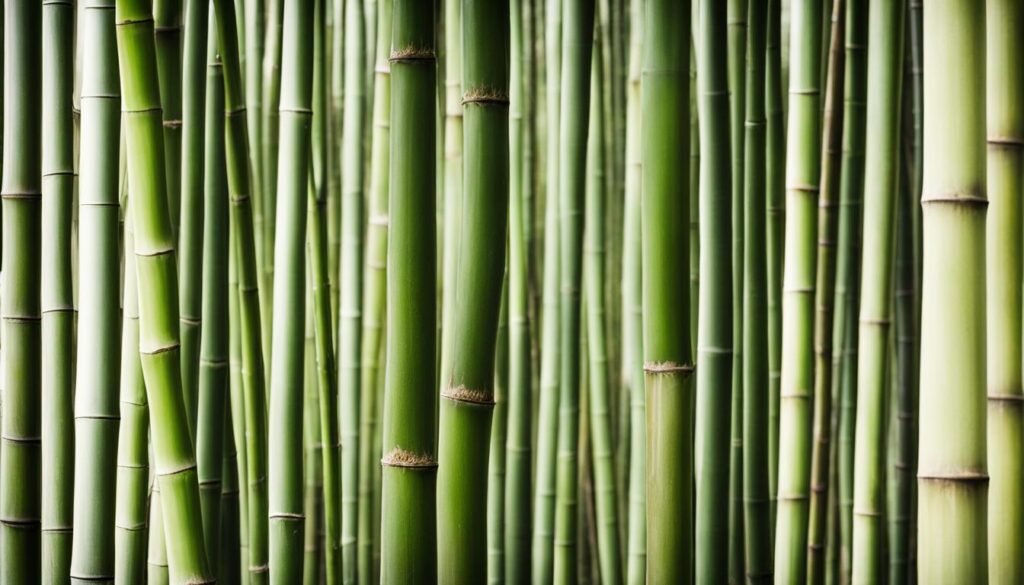
| Symbolic Meaning | Lessons Learned |
|---|---|
| Strength | The importance of resilience in the face of adversity |
| Flexibility | Adaptability and the ability to embrace change |
| Growth | The pursuit of personal development and continuous improvement |
| Harmony and Balance | The importance of finding unity within ourselves and with the world |
| Prosperity | The positive energy and blessings that come with good fortune |
| Health and Longevity | The importance of taking care of oneself and maintaining well-being |
In conclusion, bamboo symbolism holds immense significance and impact in literature and art. Its versatile meanings and diverse cultural interpretations offer valuable lessons and insights for individuals seeking resilience, adaptability, and balance in their lives. The impact of bamboo in literature and art is a testament to its enduring relevance and universal appeal as a symbol of profound cultural significance.
Bamboo Symbolize in Literature and Art
Uncovering the rich tapestry of bamboo symbolism in literature and art reveals its profound cultural and symbolic significance. From ancient literature to visual arts, bamboo has been used as a powerful tool to convey deeper meanings and themes.
Its symbolism in strength, flexibility, growth, luck, health, harmony, and balance offers a wealth of inspiration for artists and writers. The multifaceted symbolism of bamboo continues to captivate and inspire individuals in their creative pursuits.
Whether portrayed in ancient poetry, depicted in paintings, or explored in martial arts philosophy, bamboo’s enduring presence in literature and art underscores its timeless relevance and universal resonance. In exploring bamboo symbolism, we gain a deeper understanding of the multifaceted nature of this remarkable plant and its ability to convey powerful messages through various artistic mediums.
FAQ
What is the symbolic meaning of bamboo in literature and art?
Bamboo is often used as a symbol to convey deeper meanings and themes such as purity, elegance, resilience, strength, flexibility, growth, luck, health, harmony, and balance. It holds significant importance and impact in various cultural contexts.
How is bamboo symbolized in ancient literature?
In ancient literature, bamboo is often depicted as a symbol of virtue and nobility, representing qualities that individuals should aspire to. It is frequently associated with purity, elegance, and resilience, serving as a powerful metaphor in literary works.
How does bamboo symbolism manifest in visual arts?
Artists often represent bamboo as a symbol of tranquility and resilience in their paintings and calligraphy. The graceful lines of bamboo stalks are admired for their simplicity and elegance, making them a common motif in artistic depictions.
What role does bamboo play in martial arts heritage?
Bamboo inspires practitioners of martial arts through its qualities of strength and flexibility. Its ability to withstand external forces without breaking teaches the importance of resilience and adaptability in combat and life’s challenges.
How is bamboo symbolized in different cultures?
Bamboo holds symbolic significance in various cultures around the world. In Chinese culture, it is associated with virtue, resoluteness, moral integrity, and modesty. Different cultures have their own legends and myths that associate bamboo with strength, creation, and divine power.
What does bamboo symbolize in terms of strength and flexibility?
Bamboo symbolizes resilience and adaptability as it can bend with the wind without breaking. This symbolism emphasizes the value of staying strong yet adaptable in the face of challenges.
What is the association between bamboo and personal growth?
Bamboo’s rapid growth reflects human desires for continuous self-improvement. Its ability to reach great heights in a short period symbolizes the importance of personal growth and development.
What does bamboo represent in terms of luck and prosperity?
Bamboo is believed to bring blessings and good fortune in Chinese culture. The number of bamboo stalks also holds significance, with different numbers representing different types of luck. It is a popular gift and decorative element.
How is bamboo symbolized in relation to health and longevity?
Bamboo is associated with health and longevity in traditional Chinese medicine. Its modern applications include improving circulation, reducing inflammation, and promoting healing.
What does bamboo symbolize in terms of harmony and balance?
Bamboo’s elegance and gracefulness bring a sense of peace to any space, symbolizing harmony. It also represents the balance between the natural and human worlds as well as between the physical and spiritual realms.
How is bamboo practically used in everyday life?
Bamboo is used in construction, furniture, tools, crafts, culinary practices, and medicinal applications due to its strength, versatility, and health benefits.
What philosophical lessons can be learned from bamboo symbolism?
Bamboo’s adaptability and simplicity teach lessons in resilience, adaptability, contentment, and fulfillment. Its philosophy serves as a guide for finding balance and embracing a more minimalist mindset.
How is bamboo incorporated in feng shui practice?
Bamboo, particularly lucky bamboo, is used as a symbol of luck and positivity in feng shui. Different arrangements and the number of stalks have specific meanings. Bamboo is often paired with other plants to create harmonious energy and balance in a space.
What is the overall symbolic importance of bamboo in literature and art?
Bamboo symbolism holds significant cultural and artistic relevance, offering valuable lessons and insights. Its multifaceted meanings in strength, flexibility, growth, harmony, and prosperity continue to captivate and inspire individuals in their creative pursuits.



